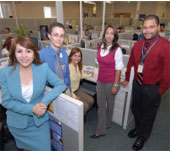
Where Security Fits In
As Puerto Rico sees a growing aerospace presence, security pros might benefit from keeping close watch
- By Karina Sanchez
- Jan 03, 2008
Deemed the rum capital of the world
and the birthplace of salsa music,
Puerto Rico has reason to celebrate.
The commonwealth’s most recent
initiative is to promote itself as being the location
of choice for aerospace-related enterprises, and
the aerospace industry is reacting positively. In
late November, the Puerto Rico Industrial
Development Co., PRIDCO, invited aerospace
industry executives to the island for its first-annual
Aerospace Vision Conference. Key executives
from Honeywell, Hamilton Sundstrand and
Infotech Aerospace Services, a division of Pratt and Whitney, all took
part in the conference, as well as professors of engineering from local
universities. The conference’s focus was clear—to bring aerospace professionals
together from the private sector and academia to discuss how
the two segments can work together to facilitate the industry’s growth
within the island.
Puerto Rico, which has been a pharmaceutical powerhouse for years
with 13 of the 20 leading U.S. prescription drugs being manufactured
there, now looks to boost its aerospace and defense presence.
“[Aerospace] is an industry that receives more orders than it can produce,”
said Vicente Nazario, general manager of Hamilton Sundstrand.
The industry’s most recent figures show that it produced $184 billion
in sales, and Puerto Rican officials are keeping a close eye on the
industry’s growth as its aerospace presence flourishes. In 1999,
Sundstrand merged with Hamilton Standard to create Hamilton
Sundstrand, and in 2001, the company started doing electronics in
Puerto Rico. Infotech set up shop in 2003, and companies like
Honeywell’s aerospace division, Florida Turbine Technologies and
Essig Research followed suit.
WHAT’S ALL THE FUSS ABOUT?
So what’s the big attraction—minus the beautiful beaches and mild climate?
The main factors are the island’s cost-competitiveness, its strong
ties to the United States and its skilled and loyal workforce. According
to the World Bank, Puerto Rico is ranked among the 20 most-favorable
countries in the world to do business. And KPMG’s Competitive
Alternatives study ranks it as the No. 1 cost-competitive location in the
United States. But what aerospace professionals value most about the
island is its people.
“We were attracted to the island for the abundance of an educated
workforce,” said Rita Peralta, president of Infotech Aerospace Services.
“Here, there’s an abundance of business skills, and it gives us an opportunity
to expand our business beyond aerospace.”
Infotech is a near-shore facility providing engineering outsourcing
and other professional services to the ITAR, military, defense, aerospace
and power generation industries. It has recently begun work for
non-aerospace customers as part of its strategy to diversify its business.
The company boasts services that range from mechanical design and
aerodynamics to software and control systems and electronic hardware
systems. And its portfolio of services is only increasing.
INCREASING BUSINESS
“One of our key factors for success is that we know how to partner,”
Peralta said. “And diversification is key to us.”
Peralta expressed interest in the security industry and its offerings.
Like so many within the security industry, those in other verticals are
looking to broaden their portfolios, as well. And in this network-centric
world, network security proves to be a rising concern.
“Security of Internet protocol is very critical,” Peralta said.
Though that’s a sentiment felt across multiple disciplines, Infotech,
in its partnership with the University of Puerto Rico, Mayaguez, is
doing something about it. The University of Puerto Rico’s college of
engineering is working to create a network security certificate, much
like a network security minor in the states.
“In our conversations with the industry, there are talks of what will
be the specialized needs of the future,” said Ramon Vasquez Espinosa,
dean of the University of Puerto Rico, Mayaguez, college of engineering.
“We take into consideration their input and then take into consideration
the knowledge of our professors, and we then decide what type
of certificate to create.”
EDUCATE THE MASSES
With Puerto Rico’s drive to grow its knowledge-based workforce, a
close relationship between industry executives and universities is paramount.
The more informed a student is in a specialized field upon graduation,
a more skilled employee they will be in the industry. And
because networks are so vital to a global economy today, it’s no wonder
that industry executives are pushing universities to embrace a network
security focus.
“1999 to 2000 showed how old computer systems really were,”
said Steve Witalis, IT manager for Infotech. “But 9/11 really made
things happen.”
Today, many companies work to educate their IT workforce on security
competencies. And many aerospace enterprises in Puerto Rico are
honing in on local universities to jump start those competencies, resulting
in what is evident to be a staff of much younger employees. But with an
aging workforce and the ripple effects felt by the loss of talent, starting at
the college level may not be such a bad idea.
“It’s not so much an issue of national security, but a workforce issue,”
said Brenda Santiago, economic and workforce development advisor for
the Department of Labor. “Newer generations want innovation.”
With fresh, energetic minds populating the Puerto Rican workforce,
more and more big players are embracing the move.
“There’s a culture of energy and warmth here. It’s a mix of skill and
culture that wants to drive change,” said Honeywell’s Mario Coracides.
And change is exactly what drives growth and presence in any industry.
It might just be a change of perspective from the security front that
may lead to security’s own growing presence
in Puerto Rico. The island’s calling,
but is the industry ready to answer?